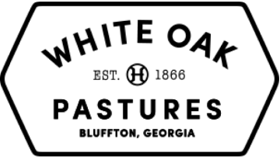So... today the farmer gets less than a dime of today's food dollar...
My great grandfather and great grandfather got 100 cents of the retail price of the food that they produced on this farm. They slaughtered animals every day, on our farm, 6 days per week, before dawn. A cow, or a couple of hogs, or a flock of chickens, or whatever other animals that they had produced… and they made it their business to have something to slaughter so that they would have something to sell.
They, or their employees, loaded the dressed meat on a mule drawn wagon and hauled it 3 miles up a dirt road to the town of Bluffton. There they sold the meat to a boarding house, two hotels, a restaurant, or peoples' homes. They had to sell it or smell it.
[This was before internal combustion engines, refrigeration, USDA inspection, etc.]
They ran a very successful family farm and prospered. My father took over the farm in 1946, post war. He modernized the farm's production system.
Under his watch, our farm ceased to produce any specie except cattle and he did not slaughter the cattle that he produced on the farm. He shipped them to the midwest for confinement feeding and industrial beef slaughter. He was profitable and liked the industrialized, commoditized, centralized model. I graduated with an animal science degree from the University of Georgia and came home to run our family farm exactly as my father did.
I loved it for the first 20 years that I did it. [as my father did for his entire career]. The big meat business was competitive enough that there were margin dollars left available to stockmen. But… consolidation of big meat companies allowed them to siphon off more, and more, and more of the margin dollars that previously had gone to farmers.
This loss of margin, and the other changes that it necessitated, caused me to tire of the excesses of this production model. The environmental impact, the animal welfare, and the impoverishment of the rural community. So 25 years ago I left this modern beef production model and returned to a production model that more closely resembled the model of my grandfather and my great grandfather. We raise, slaughter, and market beef, lamb, pork, poultry and other products directly from our farm.
Today our farm again gets 100 cents of every food dollar that we ship directly to consumers.
- Last year we did $30 million in volume.
- Today we employ 160 employees. [Instead of 4]. We are the largest employer in Clay County, Georgia.
- Our payroll is $100,000 per week in Clay County, Georgia. [The poorest county in the USA in 2020]
- Our farm made over $1 million net profit last year. [Instead of breaking even]
- Our animal welfare is exemplary.
- Our town has become a beautiful little village. [Instead of being a ghost town]
The industrialization of the meat business has been very good for the few multinational meat companies who control it. There is a better way for the other nearly 99% of us.
- Will Harris
White Oak Pastures

